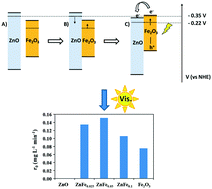当前位置:
X-MOL 学术
›
Catal. Sci. Technol.
›
论文详情
Our official English website, www.x-mol.net, welcomes your feedback! (Note: you will need to create a separate account there.)
Electron transfer in ZnO–Fe2O3 aqueous slurry systems and its effects on visible light photocatalytic activity
Catalysis Science & Technology ( IF 5 ) Pub Date : 2017-08-10 00:00:00 , DOI: 10.1039/c7cy01085k H. Lachheb 1, 2, 3, 4, 5 , F. Ajala 1, 2, 3, 4, 5 , A. Hamrouni 1, 2, 3, 4, 5 , A. Houas 1, 2, 3, 4, 5 , F. Parrino 6, 7, 8, 9, 10 , L. Palmisano 6, 7, 8, 9, 10
Catalysis Science & Technology ( IF 5 ) Pub Date : 2017-08-10 00:00:00 , DOI: 10.1039/c7cy01085k H. Lachheb 1, 2, 3, 4, 5 , F. Ajala 1, 2, 3, 4, 5 , A. Hamrouni 1, 2, 3, 4, 5 , A. Houas 1, 2, 3, 4, 5 , F. Parrino 6, 7, 8, 9, 10 , L. Palmisano 6, 7, 8, 9, 10
Affiliation

|
ZnFex (x = 0.025, 0.05, and 0.1) nanocomposites and pure ZnO and Fe2O3 photocatalysts were synthesized by a simple sol–gel route and characterized by means of specific surface area (SSA) analysis, X-ray diffraction (XRD), diffuse reflectance spectroscopy (DRS), and transmission electron microscopy/energy dispersive X-ray spectroscopy (TEM/EDS). Their photocatalytic activity was investigated under visible light by using methylene blue (MB) and benzoic acid (BA) as model compounds. Coupling ZnO and Fe2O3 results in higher photocatalytic activity with respect to the pure materials. Photoelectrochemical characterization performed in slurry systems allowed the elucidation of the electronic structure of the nanocomposites under conditions strongly mimicking the photocatalytic reaction medium. Intense electronic interactions between ZnO and Fe2O3 induce a shift of the bandgap absorption to longer wavelengths. Furthermore a shift of the photogenerated electron potential towards less negative values could be evidenced for the first time by means of these measurements. The electronic configuration obtained after coupling the two semiconductors reduces recombination through efficient electron transfer from Fe2O3 to ZnO, thus justifying the observed photoactivity results.
中文翻译:

ZnO–Fe 2 O 3水性浆料体系中的电子转移及其对可见光光催化活性的影响
ZnFe x(x = 0.025、0.05和0.1)纳米复合材料以及纯ZnO和Fe 2 O 3光催化剂通过简单的溶胶-凝胶路线合成,并通过比表面积(SSA)分析,X射线衍射(XRD)进行表征),漫反射光谱(DRS)和透射电子显微镜/能量色散X射线光谱(TEM / EDS)。使用亚甲基蓝(MB)和苯甲酸(BA)作为模型化合物,在可见光下研究了它们的光催化活性。ZnO和Fe 2 O 3的耦合导致相对于纯净材料具有更高的光催化活性。在浆料系统中进行的光电化学表征使得可以在强烈模仿光催化反应介质的条件下阐明纳米复合材料的电子结构。ZnO和Fe 2 O 3之间强烈的电子相互作用引起了带隙吸收向更长波长的转移。此外,借助于这些测量,首次可以证明光生电子势向负值的偏移。耦合两个半导体后获得的电子结构通过有效地从Fe 2 O 3转移电子来减少复合 为ZnO,因此证明了观察到的光活性结果是合理的。
更新日期:2017-09-19
中文翻译:

ZnO–Fe 2 O 3水性浆料体系中的电子转移及其对可见光光催化活性的影响
ZnFe x(x = 0.025、0.05和0.1)纳米复合材料以及纯ZnO和Fe 2 O 3光催化剂通过简单的溶胶-凝胶路线合成,并通过比表面积(SSA)分析,X射线衍射(XRD)进行表征),漫反射光谱(DRS)和透射电子显微镜/能量色散X射线光谱(TEM / EDS)。使用亚甲基蓝(MB)和苯甲酸(BA)作为模型化合物,在可见光下研究了它们的光催化活性。ZnO和Fe 2 O 3的耦合导致相对于纯净材料具有更高的光催化活性。在浆料系统中进行的光电化学表征使得可以在强烈模仿光催化反应介质的条件下阐明纳米复合材料的电子结构。ZnO和Fe 2 O 3之间强烈的电子相互作用引起了带隙吸收向更长波长的转移。此外,借助于这些测量,首次可以证明光生电子势向负值的偏移。耦合两个半导体后获得的电子结构通过有效地从Fe 2 O 3转移电子来减少复合 为ZnO,因此证明了观察到的光活性结果是合理的。



























 京公网安备 11010802027423号
京公网安备 11010802027423号